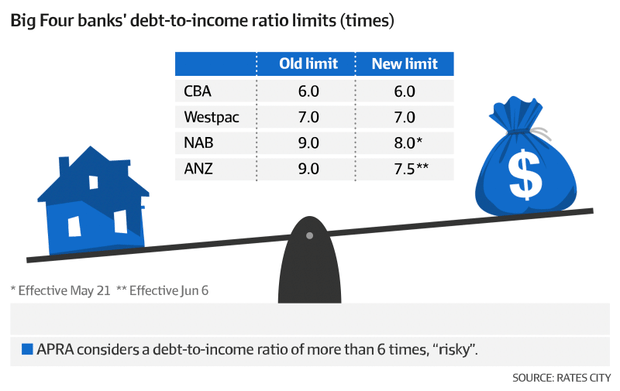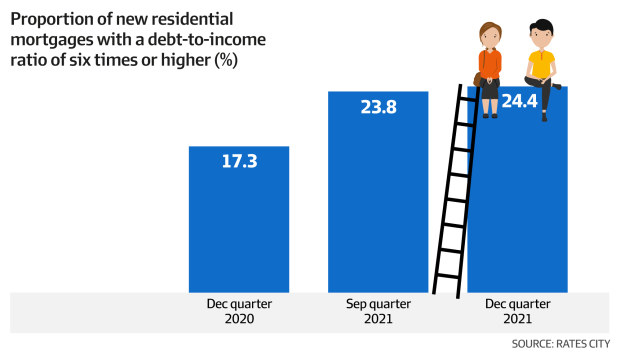Is It Easy to Get a Home Loan
Have banks put new lending parameters in place?
The banks are now making it harder for some people to get a loan because of their changes to what they view as acceptable debt-to-income ratios.
APRA said last week it would target banks that operate with higher DTI ratios, which means more risky lending. As a result, National Australia Bank and ANZ Bank reduced their maximum ratios from nine times (which means they would have let you have a loan that's a maximum of nine times the size of your income) to 7.5 times for ANZ and eight times for NAB.

Commonwealth Bank and Westpac say most of their loans are closer to six times and seven times, but they'll use different "expense floors" and will add extra fat into your monthly expenses to make sure you can service your loan if your income pushes the ratio out to nine times. So far, APRA hasn't asked them to rein in this lending.
Another change is the way the banks calculate your minimum monthly expenses. The banks use a benchmark model, assessing every quarter whether there have been changes to the macroeconomic environment. With inflation pushing up household spending on such things as petrol, groceries and utility bills, this rising benchmark will crimp what you can borrow.
The banks are also now asking for more information when they see big one-off expenses, meaning first home buyers, in particular, need to pay attention to their spending and be ready to justify any big-ticket items.
Anecdotally, the banks have been following up on everything from extra daycare expenses to extravagant bar tabs.
"If you've got two parents working and kids under school age, they're drilling into childcare expenses much more closely," Newbridge Home Loans' Richard Jefferies says.
How do the banks adjust for different levels of risk?
One of the biggest obstacles for people trying to get into the property market is that banks make you pay more for your loan if you've got a lower deposit. The higher the loan-to-value-ratio (or the lower your deposit/equity in your home), the higher your interest rate.
Westpac now offers discounts to lock in new customers for two years, but at ANZ, for example, someone with an LVR of 70 per cent pays 2.23 per cent and the rate rises to 3.23 per cent if you're at a 90 per cent LVR.
APRA has made it clear it regulates the banks for stability of the financial system – not to cool the property market.
But in December 2014, the authority introduced serviceability measures to put the brakes on a runaway housing market and required banks to assess all borrowers against a rise of 200 basis points, or a floor of 7 per cent. In 2019, it scrapped the rule.
So far, it has decided not to impose blanket caps on debt to equity, or other measures, but it has said it is watching certain banks more closely to make sure "riskier" lending doesn't blow out.

Debt-to-income ratios of six and over are considered "risky" by APRA, and the level of these loans has gone up with rising property prices and low interest rates.
The latest quarterly authorised deposit-taking institution property exposure report for the December 2021 quarter shows 24.4 per cent of new mortgages had a DTI ratio of six times or more in dollar terms. This is up from 23.8 per cent in the September quarter, and a year ago it was just 17.3 per cent.
Higher levels of indebtedness in a rising rate environment increase the potential that people won't be able to service their loans. This is particularly the case as wages have not been rising as fast as the Reserve Bank had indicated was needed to justify rate increases.
Are banks worried about repayment failures?
Against the backdrop of rising rates, there's lots of talk about the number of home owners who are ahead on their repayments – in the case of banks such as National Australia Bank by more than four years on average. This is because borrowers who have had loans for a long time saw their interest rates fall for 11 years while the bank kept their repayments steady. This increased the amount of principal paid off the loan each month.
As rates rise, those same customers won't see their repayments go up until the rate reaches that seen when they took out their loan. The cash rate has just gone up to 0.85 per cent. In October 2011, before rates started to fall, it was 4.75 per cent, so there's a lot of headroom before those people who've been in the market for a while and haven't refinanced take a hit to their pockets.
For the unlucky people who bought houses just before the cycle turned, and with the property market at or near record highs, it's a different story. Not only is the value of their home likely to fall, potentially putting those who had smaller deposits into a situation where their loan is worth more than their home, they'll also see repayments go up straight away.
Combined with the increasing price of petrol, groceries, utility bills and all the other factors driving inflation, newer home owners are going to feel the pinch, and banks will be watching closely.
If the property market cools too quickly, these home owners are the ones who will face potential difficulties as their asset could be worth less than their loans.
Source: https://www.afr.com/companies/financial-services/why-it-is-about-to-get-harder-to-get-a-home-loan-20220601-p5aq7g

0 Response to "Is It Easy to Get a Home Loan"
Post a Comment